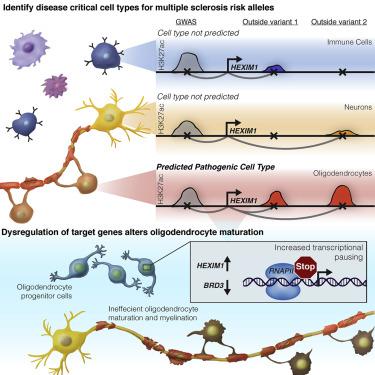Our official English website, www.x-mol.net, welcomes your
feedback! (Note: you will need to create a separate account there.)
Cell Type-Specific Intralocus Interactions Reveal Oligodendrocyte Mechanisms in MS.
Cell ( IF 45.5 ) Pub Date : 2020-04-03 , DOI: 10.1016/j.cell.2020.03.002 Daniel C Factor 1 , Anna M Barbeau 2 , Kevin C Allan 1 , Lucille R Hu 1 , Mayur Madhavan 1 , An T Hoang 2 , Kathryn E A Hazel 2 , Parker A Hall 3 , Sagar Nisraiyya 2 , Fadi J Najm 1 , Tyler E Miller 4 , Zachary S Nevin 1 , Robert T Karl 1 , Bruna R Lima 2 , Yanwei Song 2 , Alexandra G Sibert 2 , Gursimran K Dhillon 1 , Christina Volsko 5 , Cynthia F Bartels 1 , Drew J Adams 1 , Ranjan Dutta 5 , Michael D Gallagher 2 , William Phu 3 , Alexey Kozlenkov 6 , Stella Dracheva 6 , Peter C Scacheri 7 , Paul J Tesar 1 , Olivia Corradin 2
Cell ( IF 45.5 ) Pub Date : 2020-04-03 , DOI: 10.1016/j.cell.2020.03.002 Daniel C Factor 1 , Anna M Barbeau 2 , Kevin C Allan 1 , Lucille R Hu 1 , Mayur Madhavan 1 , An T Hoang 2 , Kathryn E A Hazel 2 , Parker A Hall 3 , Sagar Nisraiyya 2 , Fadi J Najm 1 , Tyler E Miller 4 , Zachary S Nevin 1 , Robert T Karl 1 , Bruna R Lima 2 , Yanwei Song 2 , Alexandra G Sibert 2 , Gursimran K Dhillon 1 , Christina Volsko 5 , Cynthia F Bartels 1 , Drew J Adams 1 , Ranjan Dutta 5 , Michael D Gallagher 2 , William Phu 3 , Alexey Kozlenkov 6 , Stella Dracheva 6 , Peter C Scacheri 7 , Paul J Tesar 1 , Olivia Corradin 2
Affiliation

|
Multiple sclerosis (MS) is an autoimmune disease characterized by attack on oligodendrocytes within the central nervous system (CNS). Despite widespread use of immunomodulatory therapies, patients may still face progressive disability because of failure of myelin regeneration and loss of neurons, suggesting additional cellular pathologies. Here, we describe a general approach for identifying specific cell types in which a disease allele exerts a pathogenic effect. Applying this approach to MS risk loci, we pinpoint likely pathogenic cell types for 70%. In addition to T cell loci, we unexpectedly identified myeloid- and CNS-specific risk loci, including two sites that dysregulate transcriptional pause release in oligodendrocytes. Functional studies demonstrated inhibition of transcriptional elongation is a dominant pathway blocking oligodendrocyte maturation. Furthermore, pause release factors are frequently dysregulated in MS brain tissue. These data implicate cell-intrinsic aberrations outside of the immune system and suggest new avenues for therapeutic development. VIDEO ABSTRACT.
中文翻译:

细胞类型特异性的位点内相互作用揭示了多发性硬化症中的少突胶质细胞机制。
多发性硬化症 (MS) 是一种自身免疫性疾病,其特征是攻击中枢神经系统 (CNS) 内的少突胶质细胞。尽管广泛使用免疫调节疗法,但由于髓磷脂再生失败和神经元丢失,患者仍可能面临进行性残疾,这表明存在额外的细胞病理。在这里,我们描述了一种识别特定细胞类型的通用方法,其中疾病等位基因发挥致病作用。将这种方法应用于多发性硬化症风险位点,我们可以查明 70% 的可能致病细胞类型。除了 T 细胞位点外,我们还意外地发现了骨髓和 CNS 特异性风险位点,包括少突胶质细胞中转录暂停释放失调的两个位点。功能研究表明,抑制转录延伸是阻碍少突胶质细胞成熟的主要途径。此外,多发性硬化症脑组织中的暂停释放因子经常失调。这些数据暗示了免疫系统之外的细胞内在畸变,并为治疗开发提出了新途径。视频摘要。
更新日期:2020-04-20
中文翻译:

细胞类型特异性的位点内相互作用揭示了多发性硬化症中的少突胶质细胞机制。
多发性硬化症 (MS) 是一种自身免疫性疾病,其特征是攻击中枢神经系统 (CNS) 内的少突胶质细胞。尽管广泛使用免疫调节疗法,但由于髓磷脂再生失败和神经元丢失,患者仍可能面临进行性残疾,这表明存在额外的细胞病理。在这里,我们描述了一种识别特定细胞类型的通用方法,其中疾病等位基因发挥致病作用。将这种方法应用于多发性硬化症风险位点,我们可以查明 70% 的可能致病细胞类型。除了 T 细胞位点外,我们还意外地发现了骨髓和 CNS 特异性风险位点,包括少突胶质细胞中转录暂停释放失调的两个位点。功能研究表明,抑制转录延伸是阻碍少突胶质细胞成熟的主要途径。此外,多发性硬化症脑组织中的暂停释放因子经常失调。这些数据暗示了免疫系统之外的细胞内在畸变,并为治疗开发提出了新途径。视频摘要。











































 京公网安备 11010802027423号
京公网安备 11010802027423号